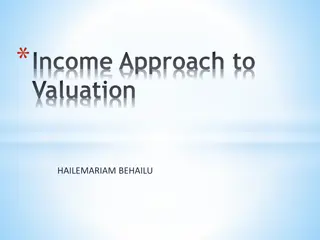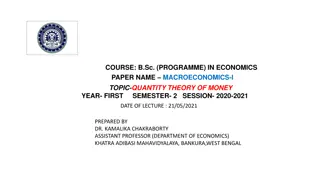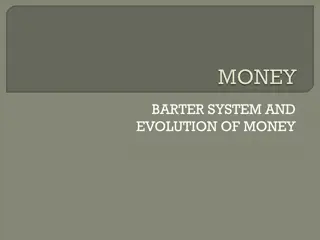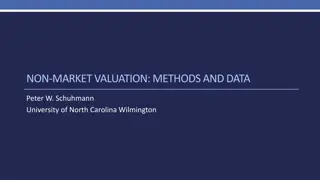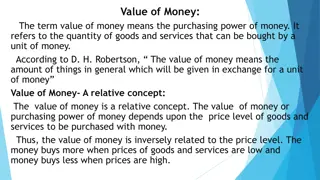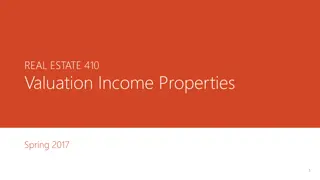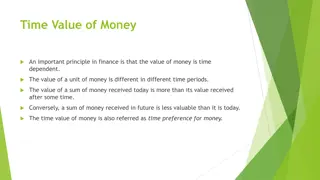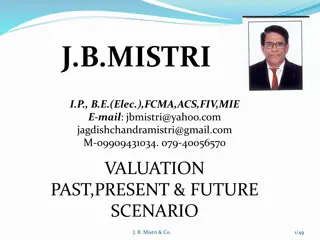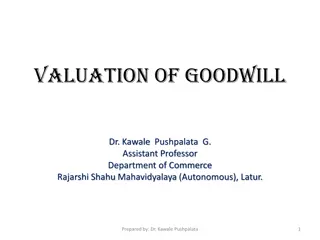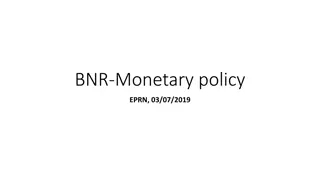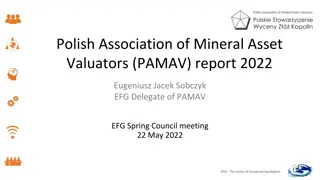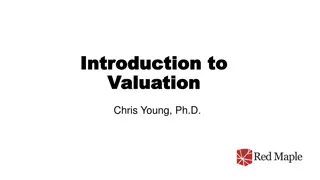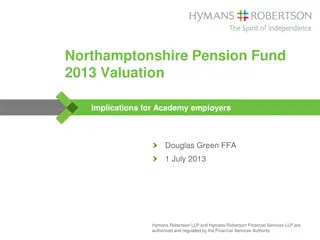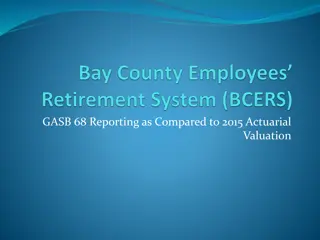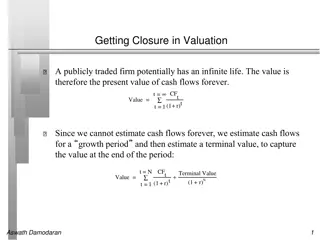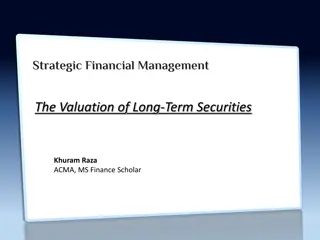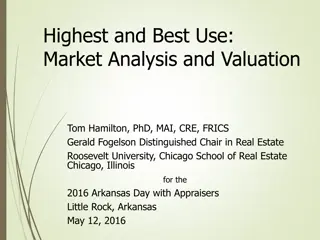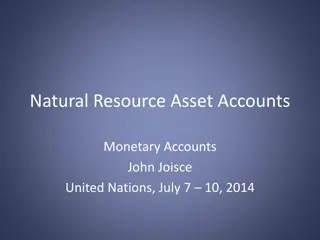Valuation Fundamentals: The Time Value of Money
The concept of time value of money is crucial in financial decision-making. Learn how to calculate future and present values, returns on investments, and more. Understand the significance of interest rates and how they impact the value of money over time.
Download Presentation

Please find below an Image/Link to download the presentation.
The content on the website is provided AS IS for your information and personal use only. It may not be sold, licensed, or shared on other websites without obtaining consent from the author.If you encounter any issues during the download, it is possible that the publisher has removed the file from their server.
You are allowed to download the files provided on this website for personal or commercial use, subject to the condition that they are used lawfully. All files are the property of their respective owners.
The content on the website is provided AS IS for your information and personal use only. It may not be sold, licensed, or shared on other websites without obtaining consent from the author.
E N D
Presentation Transcript
INTRODUCTION TO VALUATION: THE TIME VALUE OF MONEY CHAPTER CHAPTER 5 5
Key Concepts and Skills Be able to compute the future value of an investment made today Be able to compute the present value of cash to be received at some future date Be able to compute the return on an investment Be able to compute the number of periods that equates a present value and a future value given an interest rate
Chapter Outline Future Value and Compounding Present Value and Discounting More about Present and Future Values
Introduction The Time Value of Money Would you prefer to have $1 million now or $1 million 10 years from now? Of course, we would all prefer the money now! This illustrates that there is an inherent monetary value attached to time.
What is The Time Value of Money? A dollar received today is worth more than a dollar received tomorrow This is because a dollar received today can be invested to earn interest The amount of interest earned depends on the rate of return that can be earned on the investment Time value of money quantifies the value of a dollar through time
Basic Definitions Present Value earlier money on a time line Future Value later money on a time line Interest rate exchange rate between earlier money and later money Compound Interest - Interest earned on interest. Simple Interest - Interest earned only on the original investment.
Basic Definitions Discount rate Cost of capital Opportunity cost of capital Required return
Future Values Suppose you invest $1,000 for one year at 5% per year. What is the future value in one year? Interest = 1,000(.05) = 50 Value in one year = principal + interest = 1,000 + 50 = 1,050 Future Value (FV) = 1,000(1 + .05) = 1,050 Suppose you leave the money in for another year. How much will you have two years from now? FV = 1,000(1.05)(1.05) = 1,000(1.05)2= 1,102.50
Future Values Example - Simple Interest Interest earned at a rate of 6% for five years on a principal balance of $100. Today Future Years 2 6 112 1 3 6 118 4 6 5 6 Interest Earned Value 6 124 130 100 106 Value at the end of Year 5 = $130
Future Values Example - Compound Interest Interest earned at a rate of 6% for five years on the previous year s balance. Interest Earned Per Year =Prior Year Balance x .06
Future Values Example - Compound Interest Interest earned at a rate of 6% for five years on the previous year s balance. Today Future Years 2 6.36 112.36 1 6 3 4 5 7.57 133.82 Interest Earned Value 6.74 119.10 7.15 126.25 100 106 Value at the end of Year 5 = $133.82
Future Values: General Formula FV = PV(1 + r)t FV = future value PV = present value r = period interest rate, expressed as a decimal t = number of periods Future value interest factor = (1 + r)t
Effects of Compounding Consider the previous example FV with simple interest = 1,000 + 50 + 50 = 1,100 FV with compound interest = 1,102.50 The extra 2.50 comes from the interest of .05(50) = 2.50 earned on the first interest payment
Future Values Example Suppose you invest the $1,000 from the previous example for 5 years. How much would you have? FV = 1,000(1.05)5= 1,276.28 The effect of compounding is small for a small number of periods, but increases as the number of periods increases. (Simple interest would have a future value of $1,250, for a difference of $26.28.)
Future Values Example Suppose you had a relative deposit $10 at 5.5% interest 200 years ago. How much would the investment be worth today? FV = 10(1.055)200= 447,189.84 What is the effect of compounding? Simple interest = 10 + 200(10)(.055) = 120.00 Compounding added $447,069.84 to the value of the investment
Future Value as a General Growth Formula Suppose your company expects to increase unit sales of widgets by 15% per year for the next 5 years. If you currently sell 3 million widgets in one year, how many widgets do you expect to sell in 5 years? FV = 3,000,000(1.15)5= 6,034,072
Quick Quiz Part I What is the difference between simple interest and compound interest? Suppose you have $500 to invest and you believe that you can earn 8% per year over the next 15 years. How much would you have at the end of 15 years using compound interest? How much would you have using simple interest?
Present Values How much do I have to invest today to have some amount in the future? FV = PV(1 + r)t Rearrange to solve for PV = FV / (1 + r)t When we talk about discounting, we mean finding the present value of some future amount. When we talk about the value of something, we are talking about the present value unless we specifically indicate that we want the future value
Present Value One Period Example Suppose you need $10,000 in one year for the down payment on a new car. If you can earn 7% annually, how much do you need to invest today? PV = 10,000 / (1.07)1= 9,345.79
Present Values Example 2 You want to begin saving for your daughter s college education and you estimate that she will need $150,000 in 17 years. If you feel confident that you can earn 8% per year, how much do you need to invest today? PV = 150,000 / (1.08)17= 40,540.34
Present Values Example 3 Your parents set up a trust fund for you 10 years ago that is now worth $19,671.51. If the fund earned 7% per year, how much did your parents invest? PV = 19,671.51 / (1.07)10= 10,000
Present Value Important Relationship I For a given interest rate the longer the time period, the lower the present value What is the present value of $500 to be received in 5 years? 10 years? The discount rate is 10% 5 years: PV = 500 / (1.1)5= 310.46 10 years: PV = 500 / (1.1)10= 192.77
Present Value Important Relationship II For a given time period the higher the interest rate, the smaller the present value What is the present value of $500 received in 5 years if the interest rate is 10%? 15%? Rate = 10%: PV = 500 / (1.1)5= 310.46 Rate = 15%; PV = 500 / (1.15)5= 248.59
Quick Quiz Part II What is the relationship between present value and future value? Suppose you need $15,000 in 3 years. If you can earn 6% annually, how much do you need to invest today? If you could invest the money at 8%, would you have to invest more or less than at 6%? How much?
The Basic PV Equation - Refresher PV = FV / (1 + r)t There are four parts to this equation PV, FV, r and t If we know any three, we can solve for the fourth
Discount Rate Often we will want to know what the implied interest rate is in an investment Rearrange the basic PV equation and solve for r FV = PV(1 + r)t r = (FV / PV)1/t 1
Discount Rate Example 1 You are looking at an investment that will pay $1,200 in 5 years if you invest $1,000 today. What is the implied rate of interest? r = (1,200 / 1,000)1/5 1 = .03714 = 3.714%
Discount Rate Example 2 Suppose you are offered an investment that will allow you to double your money in 6 years. You have $10,000 to invest. What is the implied rate of interest? r = (20,000 / 10,000)1/6 1 = .122462 = 12.25%
Discount Rate Example 3 Suppose you have a 1-year old son and you want to provide $75,000 in 17 years towards his college education. You currently have $5,000 to invest. What interest rate must you earn to have the $75,000 when you need it? r = (75,000 / 5,000)1/17 1 = .172688 = 17.27%
Quick Quiz Part III What are some situations in which you might want to know the implied interest rate? You are offered the following investments: You can invest $500 today and receive $600 in 5 years. The investment is considered low risk. You can invest the $500 in a bank account paying 4%. What is the implied interest rate for the first choice and which investment should you choose?
Finding the Number of Periods Start with the basic equation and solve for t (remember your logs) FV = PV(1 + r)t t = ln(FV / PV) / ln(1 + r)
Number of Periods Example 2 Suppose you want to buy a new house. You currently have $15,000, and you figure you need to have a 10% down payment plus an additional 5% of the loan amount for closing costs. Assume the type of house you want will cost about $150,000 and you can earn 7.5% per year, how long will it be before you have enough money for the down payment and closing costs?
Example 2 Continued How much do you need to have in the future? Down payment = .1(150,000) = 15,000 Closing costs = .05(150,000 15,000) = 6,750 Total needed = 15,000 + 6,750 = 21,750 Compute the number of periods Using the formula t = ln(21,750 / 15,000) / ln(1.075) = 5.14 years
Quick Quiz Part IV When might you want to compute the number of periods? Suppose you want to buy some new furniture for your family room. You currently have $500, and the furniture you want costs $600. If you can earn 6%, how long will you have to wait if you don t add any additional money?
Comprehensive Problem You have $10,000 to invest for five years. How much additional interest will you earn if the investment provides a 5% annual return, when compared to a 4.5% annual return? How long will it take your $10,000 to double in value if it earns 5% annually? What annual rate has been earned if $1,000 grows into $4,000 in 20 years?
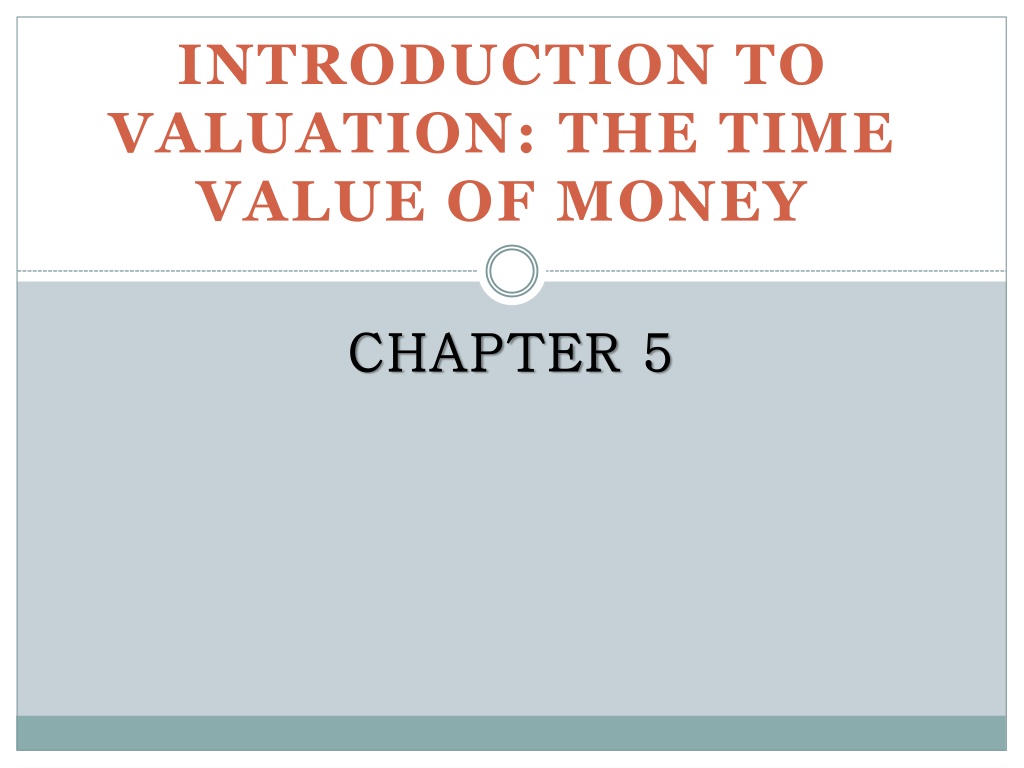
 undefined
undefined










